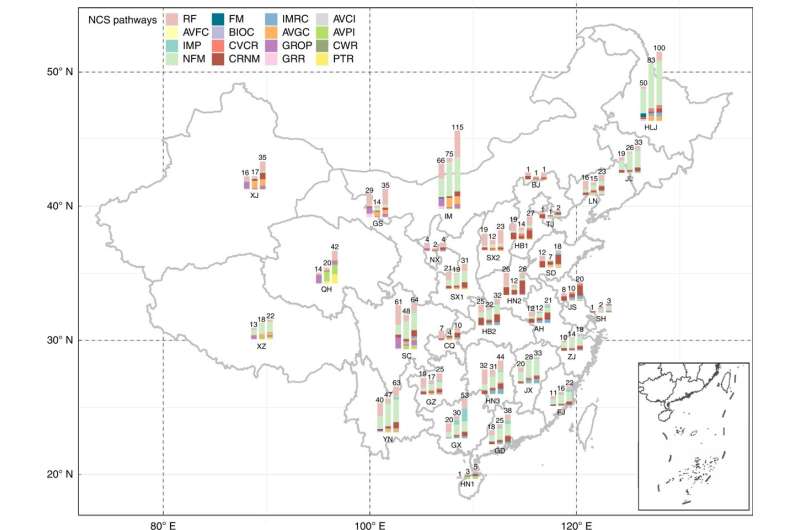Natural climate solutions help mitigate climate change in China

Natural climate solutions (NCS), which comprise various land stewardship options, are approaches to trapping carbon in terrestrial pools and/or reducing greenhouse gas (GHG) emissions. They are critical for slowing down the rate of global warming over the next few decades.
An international research group led by Prof. Fu Bojie from the Research Center for Eco-Environmental Sciences of the Chinese Academy of Sciences has now quantified China's NCS and their contribution to climate change mitigation. Results were published online in Nature Climate Change on Aug. 18.
The researchers used data from the literature, forestry inventories, public databases and policy documents to estimate the climate mitigation associated with China's 16 NCS pathways, including conservation, restoration, and improved management of forest, grassland, cropland and wetland ecosystems. Results were: 0.6 Pg (or 8% of industrial CO2 emissions) per year for 2000–2020; 0.6 Pg (or 6% of industrial CO2 emissions) per year for 2020–2030; and 1.0 Pg CO2 equivalent (CO2e) per year for 2020–2060.
If the post-2020 carbon sink from previous NCS activities is included, China's NCS would counterbalance 11–12% of industrial CO2 emissions by 2030. The researchers also calculated that 26–31%, 62–65%, and 90–91% of the future potentials can be achieved at the cost thresholds of 10, 50 and 100 US$ per Mg of CO2e, respectively.
The modest proportion of China's industrial CO2 emissions that can be counterbalanced by NCS shows that transforming energy use and rapidly applying low-carbon technologies are urgent priorities for climate mitigation. However, Prof. Fu pointed out that when it comes to achieving steep reductions in emissions, the potential of technology continues to narrow and costs continue to rise. For this reason, Prof. Fu said that "strengthening natural climate solutions will play an important role in China's Nationally Determined Contribution and carbon neutrality."
The researchers also found that different regions and provinces have distinct NCS options and mitigation potentials, due to regional heterogeneity in natural conditions, ecosystem characteristics, and management methods. The researchers suggested that in order to realize the maximum potential of NCS along with the co-benefits of biodiversity and ecosystem services, it is necessary to formulate a multilevel governance strategy that captures regional differences in various NCS pathways.
Prof. Fu said that realization of maximum mitigation potential of future ecosystems depends on "multipath management of large land areas." He also noted that "comprehensive upgrading of the nation's ecosystem management strategy" is needed.
To meet this goal, the researchers said that overall investment in ecosystem management should be ensured and efficiency improved. Due to limited natural resources and economic capital, it's necessary to carefully plan forestation, enclosing grasslands and reclaiming farmland, in order to avoid blind expansion. The researchers also noted the critical importance of protecting the existing ecosystem, and seeking diversified management pathways through technological innovation and achieving synergies.
More information: Nan Lu et al, Biophysical and economic constraints on China's natural climate solutions, Nature Climate Change (2022). DOI: 10.1038/s41558-022-01432-3
Journal information: Nature Climate Change
Provided by Chinese Academy of Sciences



















